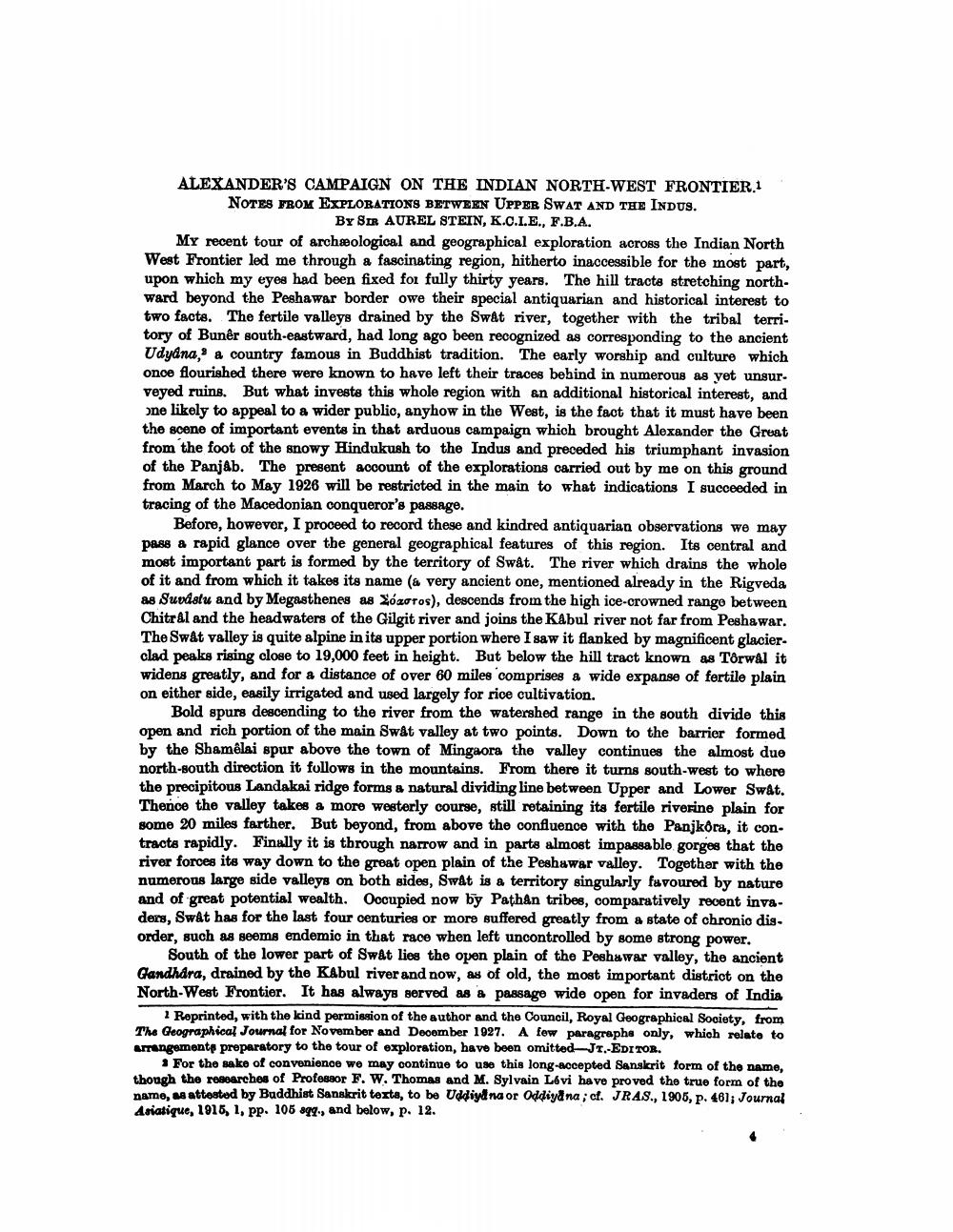________________
ALEXANDER'S CAMPAIGN ON THE INDIAN NORTH-WEST FRONTIER.1 NOTES FROM EXPLORATIONS BETWEEN UPPER SWAT AND THE INDUS.
By StR AUREL STEIN, K.C.L.E., F.B.A. My recent tour of archæological and geographical exploration across the Indian North West Frontier led me through a fascinating region, hitherto inaccessible for the most part, upon which my eyes had been fixed for fully thirty years. The hill tracte stretching northward beyond the Peshawar border owe their special antiquarian and historical interest to two facte. The fertile valleys drained by the Swat river, together with the tribal territory of Bunêr south-eastward, had long ago been recognized as corresponding to the ancient Udydna, a country famous in Buddhist tradition. The early worship and culture which once flourished there were known to have left their traces behind in numerous as yet unsurveyed ruins. But what invests this whole region with an additional historical interest, and one likely to appeal to a wider public, anyhow in the West, is the fact that it must have been the scene of important events in that arduous campaign which brought Alexander the Great from the foot of the snowy Hindukush to the Indus and preceded his triumphant invasion of the Panjab. The present account of the explorations carried out by me on this ground from March to May 1926 will be restricted in the main to what indications I succeeded in tracing of the Macedonian conqueror's passage.
Before, however, I proceed to record these and kindred antiquarian observations we may pass a rapid glance over the general geographical features of this region. Its central and most important part is formed by the territory of Swat. The river which drains the whole of it and from which it takes its name (a very ancient one, mentioned already in the Rigveda as Suvistu and by Megasthenes as Xóacros), descends from the high ice-crowned range between Chitral and the headwaters of the Gilgit river and joins the Kabul river not far from Peshawar. The Swát valley is quite alpine in ita upper portion where I saw it flanked by magnificent glacier. clad peaks rising close to 19,000 feet in height. But below the hill tract known as Tôrwal it widens greatly, and for a distance of over 60 miles comprises & wide expanse of fertile plain on either side, easily irrigated and used largely for rice cultivation.
Bold spurs descending to the river from the watershed range in the south divide this open and rich portion of the main Swat valley at two points. Down to the barrior formed by the Shamêlai spur above the town of Mingaora the valley continues the almost due north-south direction it follows in the mountains. From there it turns south-west to where the precipitous Landakai ridge forms & natural dividing line between Upper and Lower Sw&t. Thence the valley takes a more westerly course, still retaining its fertile riverine plain for some 20 miles farther. But beyond, from above the confluence with the Panjkôra, it contracts rapidly. Finally it is through narrow and in parts almost impassable gorges that the river forces its way down to the great open plain of the Peshawar valley. Together with the numerous large side valleys on both sides, Swat is a territory singularly favoured by nature and of great potential wealth. Occupied now by Pathan tribes, comparatively recent invaders, Swat has for the last four centuries or more suffered greatly from a state of chronic dis. order, such as seems endemic in that race when left uncontrolled by some strong power.
South of the lower part of Swat lies the open plain of the Peshawar valley, the ancient Gandhára, drained by the Kabul river and now, as of old, the most important district on the North-West Frontier. It has always served as a passage wide open for invaders of India
Reprinted, with the kind permission of the author and the Council, Royal Geographical Society, from The Geographical Journal for November and December 1927. A few paragraphe only, which relate to amengemente preparatory to the tour of exploration, have been omitted Jr.-EDITOR.
1 For the sake of convenience we may continue to use this long-accepted Sanskrit form of the name, though the researches of Professor F. W. Thomas and M. Sylvain Lévi have proved the true form of the DAMO, 19 attested by Buddhist Sanskrit texts, to be Uddiyd na or Oddiyd na; cf. JRAS., 1906, p. 461; Journal Asiatique, 1915, 1, pp. 105 899., and below, p. 12.




